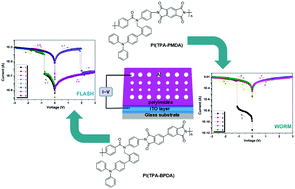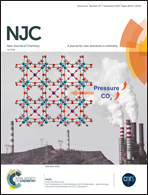Synthesis and non-volatile electrical memory characteristics of triphenylamine-based polyimides with flexibility segments†
Abstract
An efficient and readily available novel asymmetric diamine monomer containing a strongly electron-donating triphenylamine moiety and a flexibility segment was designed and synthesized through a Suzuki coupling reaction. Then, two thermally stable and highly soluble polyimides (PI(TPA-PMDA) and PI(TPA-BPDA)) were prepared and characterized. The ITO/PI(TPA-PMDA)/Al memory device exhibited write-once read-many-times (WORM) memory behavior with a threshold voltage of −1.12 V, while the PI(TPA-BPDA) memory device demonstrated flash-type memory behavior with a turn-on voltage at −0.78 V and a turn-off voltage at +1.98 V. Both devices showed high ON/OFF current ratios beyond 103 and long retention times of 4 × 103 s. Space-charge limited-current (SCLC) conduction and local filament conduction governed the OFF- and ON-state current conduction of the two memory devices, respectively. The electrical memory switching behaviors were induced by a charge transfer process under an applied electric field, and the differences between the dihedral angles and dipole moments resulted in different memory types.



 Please wait while we load your content...
Please wait while we load your content...